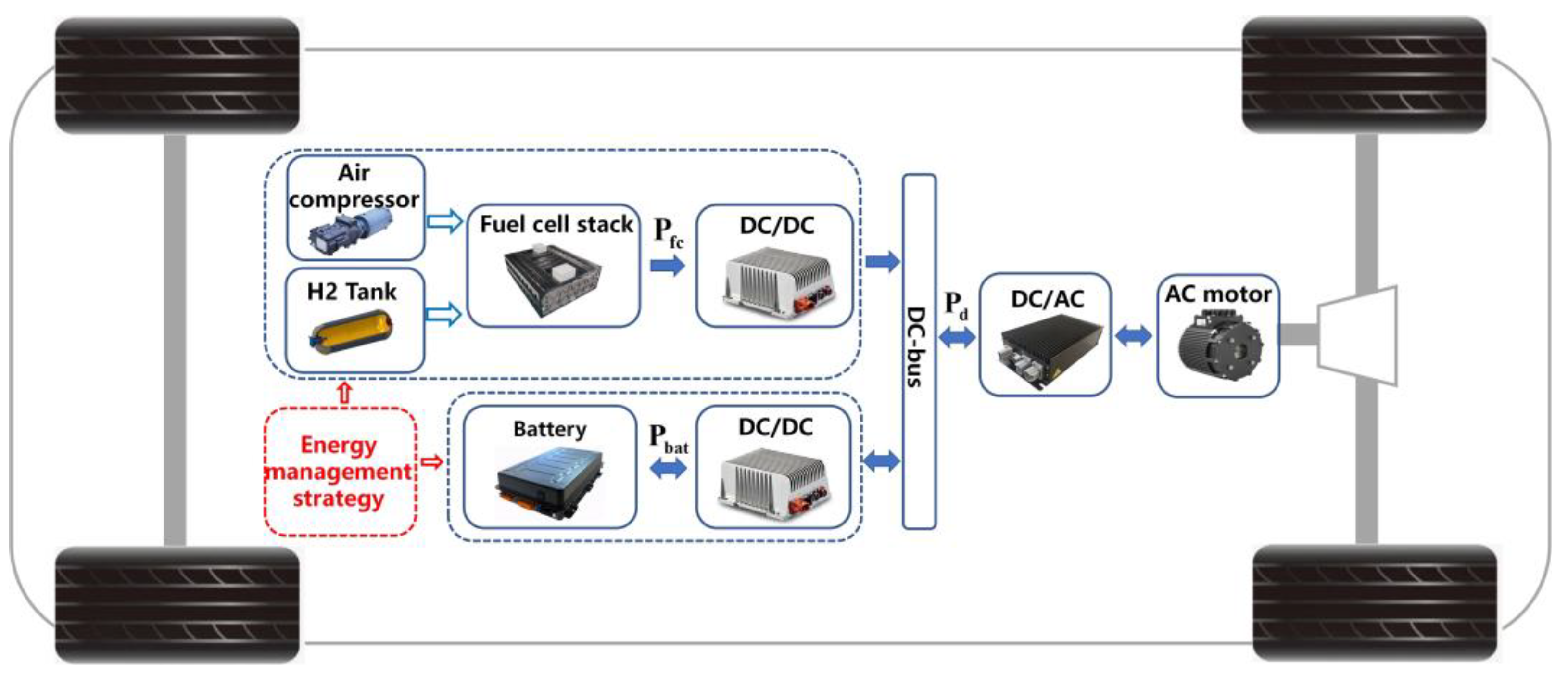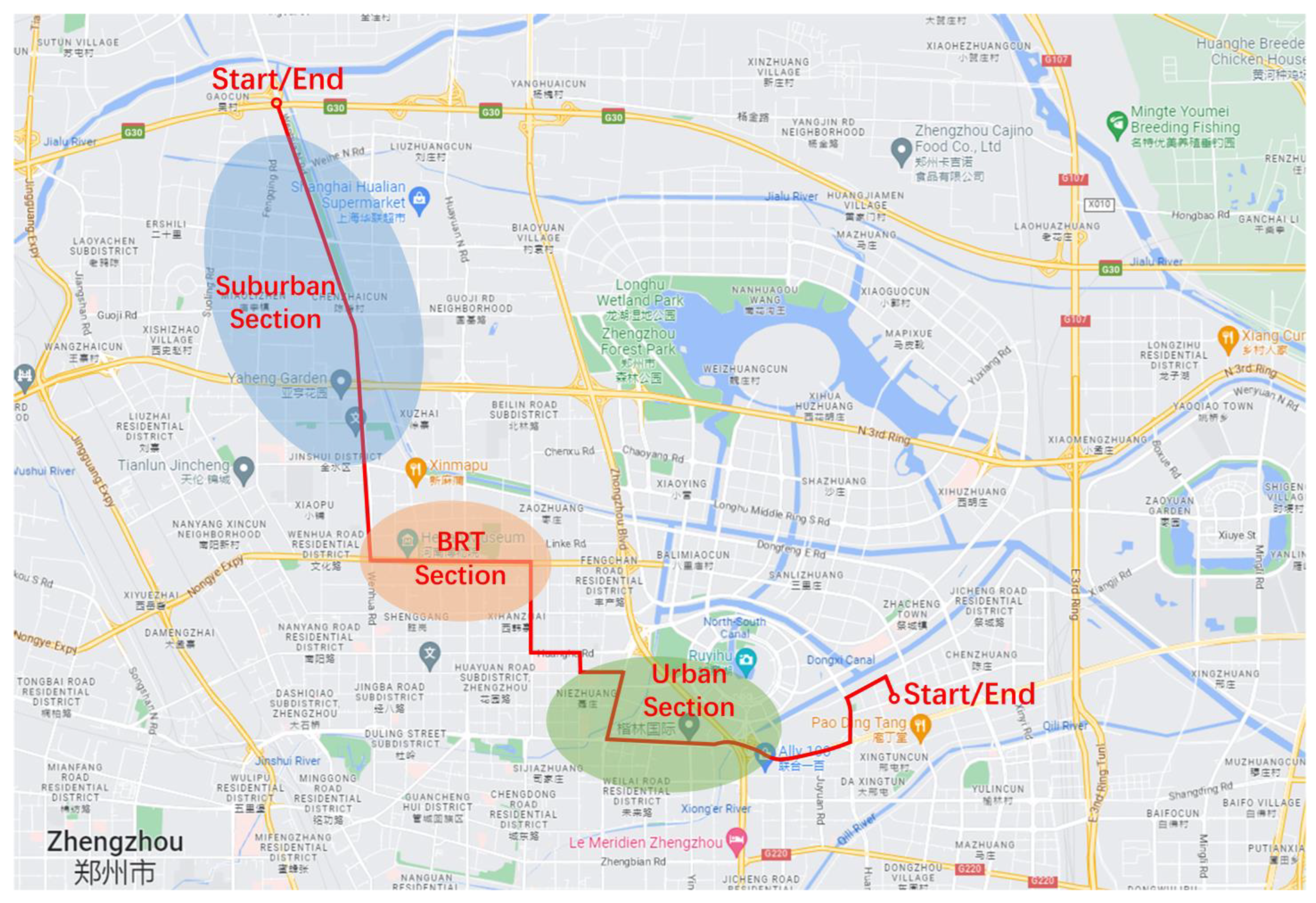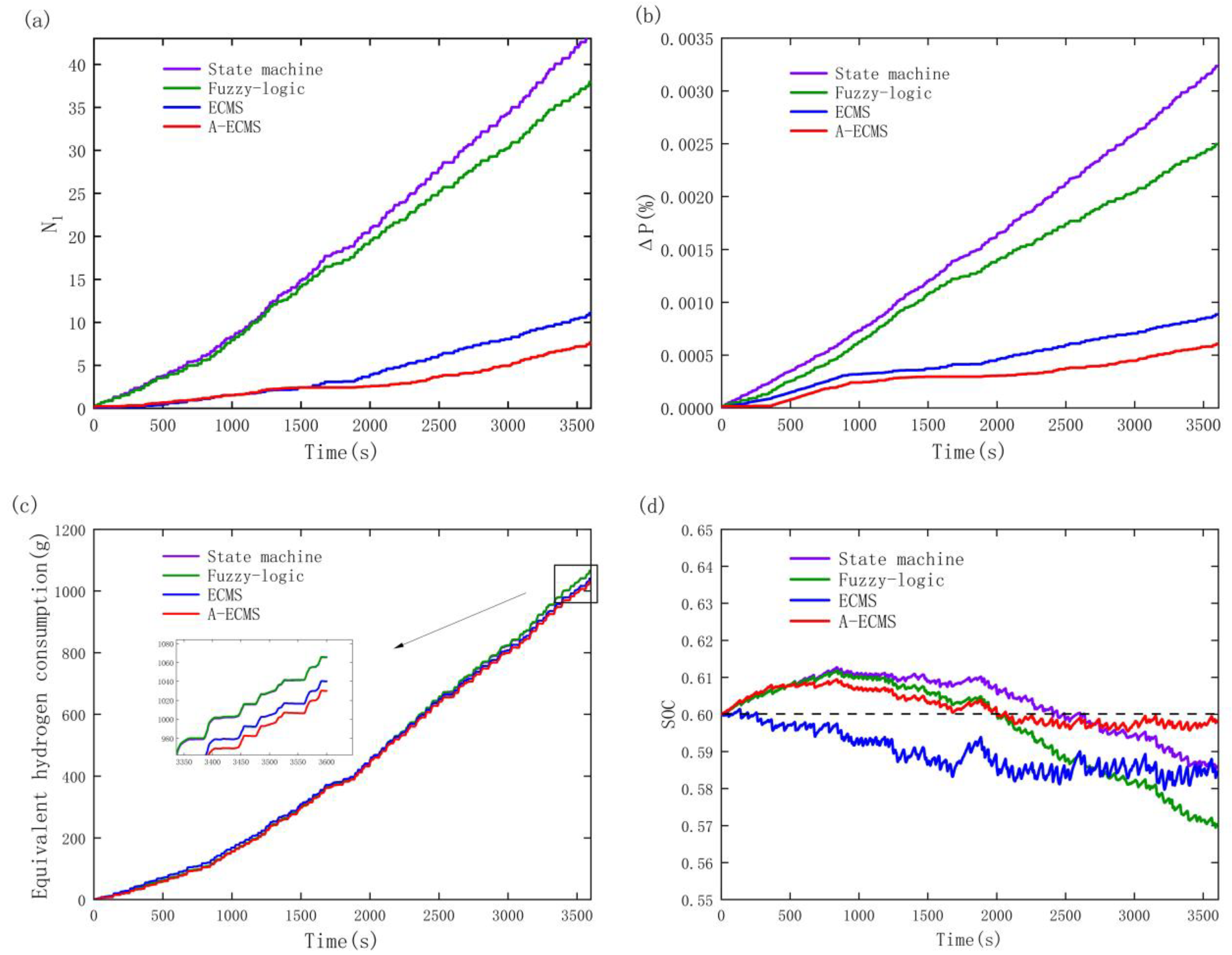Adaptive Equivalent Consumption Minimization Strategy for Fuel Cell Buses Based on Driving Style Recognition
Abstract
:1. Introduction
- (1)
- In the energy management strategy, different scholars have studied the influence of factors such as vehicle and road conditions [31,32] on the energy management strategy, integrated these influences into the reference range of the energy management strategy, and developed a variety of adaptive energy management strategies, but these methods rarely focus on the influence of the driver on the energy management strategy. This poses a new challenge to the energy management strategy of fuel cell vehicles.
- (2)
- At the same time, the high cost of fuel cells, the core component of fuel cell buses, has been one of the main factors affecting the promotion of fuel cell buses. The existing energy management strategies focus more on the hydrogen consumption cost and lack consideration of the fuel cell degradation cost [33].
- (1)
- In this paper, the influence of driving style is introduced into the FCB energy management strategy, and the parameters in the objective function are adaptively adjusted with the driving style factor to achieve the optimal control effect.
- (2)
- Multi-objective optimization incorporates equivalent hydrogen consumption and fuel cell degradation into the objective function, improving vehicle economy over the full life cycle.
2. Hybrid Powertrain Model
2.1. Powertrain Architecture
2.2. Fuel Cell Model
2.3. Battery Model
2.4. Fuel Cell Degradation Cost Model
3. Data Acquisition and Driving Cycle Construction
3.1. Data Acquisition and Pre-Processing
3.2. Principal Component Analysis and Cluster Analysis
3.3. Markov Chain-Based Driving Cycle Construction
- (1)
- Set the initial driving state to 1, and determine the state value of the next moment from the state transfer probability matrix.
- (2)
- Based on Markov chain theory, the state sequence is transformed into a velocity sequence by Equation (19).where denotes the instantaneous velocity value, denotes the instantaneous state value, is a random number with the value range [0, 1], and denotes the velocity interval of the state.
- (3)
- Calculate the characteristic parameters of the speed sequence and compare them with the actual driving cycle values to determine whether the absolute deviation value does not exceed 10%.
4. Driving Conditions and Driving Style Recognition
4.1. Driving Condition Recognition Using an Artificial Neural Network
4.2. Driving Style Recognition Based on Fuzzy Logic
5. A-ECMS Based on Driving Style
5.1. ECMS
5.2. EF Adaption Based on Driving Style Factor Using Multi-Objective Optimization
5.3. Simulation Verification
6. Conclusions
Author Contributions
Funding
Institutional Review Board Statement
Informed Consent Statement
Data Availability Statement
Acknowledgments
Conflicts of Interest
References
- Zhou, J.; Feng, C.; Su, Q.; Jiang, S.; Fan, Z.; Ruan, J.; Sun, S.; Hu, L. The Multi-Objective Optimization of Powertrain Design and Energy Management Strategy for Fuel Cell–Battery Electric Vehicle. Sustainability 2022, 14, 6320. [Google Scholar] [CrossRef]
- Jia, C.; Zhou, J.; He, H.; Li, J.; Wei, Z.; Li, K.; Shi, M. A novel energy management strategy for hybrid electric bus with fuel cell health and battery thermal- and health-constrained awareness. Energy 2023, 271, 127105. [Google Scholar] [CrossRef]
- Yao, D.; Lu, X.; Chao, X.; Zhang, Y.; Shen, J.; Zeng, F.; Zhang, Z.; Wu, F. Adaptive Equivalent Fuel Consumption Minimization Based Energy Management Strategy for Extended-Range Electric Vehicle. Sustainability 2023, 15, 4607. [Google Scholar] [CrossRef]
- Ferahtia, S.; Rezk, H.; Ghoniem, R.M.; Fathy, A.; Alkanhel, R.; Ghonem, M.M. Optimal Energy Management for Hydrogen Economy in a Hybrid Electric Vehicle. Sustainability 2023, 15, 3267. [Google Scholar] [CrossRef]
- Sagberg, F.; Selpi; Bianchi Piccinini, G.F.; Engström, J. A review of research on driving styles and road safety. Hum. Factors 2015, 57, 1248–1275. [Google Scholar] [CrossRef]
- Wang, R.; Lukic, S.M. Review of driving conditions prediction and driving style recognition based control algorithms for Hybrid Electric Vehicles. In Proceedings of the 2011 IEEE Vehicle Power and Propulsion Conference, Chicago, IL, USA, 6–9 September 2011; pp. 1–7. [Google Scholar]
- Manzie, C.; Grondin, O.; Sciarretta, A.; Zito, G. ECMS Controller Robustness in Flex-Fuel Hybrid Vehicles. J. Dyn. Syst. Meas. Control. 2014, 136, 064504. [Google Scholar] [CrossRef]
- Zhang, J.; Cheng, M.; Luo, X.; Li, H.; Luo, L.; Cheng, X.; Yan, X.; Shen, S. Current status of the research on key technologies of vehicle fuel cell stack. J. Autom. Saf. Energy 2022, 13, 1–28. [Google Scholar]
- Hannan, M.A.; Azidin, F.; Mohamed, A. Multi-sources model and control algorithm of an energy management system for light electric vehicles. Energy Convers. Manag. 2012, 62, 123–130. [Google Scholar] [CrossRef]
- Li, Q.; Yang, H.; Han, Y.; Li, M.; Chen, W. A state machine strategy based on droop control for an energy management system of PEMFC-battery-supercapacitor hybrid tramway. Int. J. Hydrog. Energy 2016, 41, 16148–16159. [Google Scholar] [CrossRef]
- Zhao, Z.-H. Improved fuzzy logic control-based energy management strategy for hybrid power system of FC/PV/battery/SC on tourist ship. Int. J. Hydrog. Energy 2022, 47, 9719–9734. [Google Scholar] [CrossRef]
- Hu, D.; Cheng, S.; Zhou, J.; Hu, L. Energy Management Optimization Method of Plug-In Hybrid-Electric Bus Based on Incremental Learning. IEEE J. Emerg. Sel. Top. Power Electron. 2021, 11, 7–18. [Google Scholar] [CrossRef]
- Wu, P.; Partridge, J.; Bucknall, R. Cost-effective reinforcement learning energy management for plug-in hybrid fuel cell and battery ships. Appl. Energy 2020, 275, 115258. [Google Scholar] [CrossRef]
- Wang, Y.; Jiao, X. Dual Heuristic Dynamic Programming Based Energy Management Control for Hybrid Electric Vehicles. Energies 2022, 15, 3235. [Google Scholar] [CrossRef]
- Broatch, A.; Olmeda, P.; Plá, B.; Dreif, A. Novel Energy Management Control Strategy for Improving Efficiency in Hybrid Powertrains. Energies 2022, 16, 107. [Google Scholar] [CrossRef]
- Xu, L.; Yang, F.; Li, J.; Ouyang, M.; Hua, J. Real time optimal energy management strategy targeting at minimizing daily operation cost for a plug-in fuel cell city bus. Int. J. Hydrog. Energy 2012, 37, 15380–15392. [Google Scholar] [CrossRef]
- Yi, F.; Lu, D.; Wang, X.; Pan, C.; Tao, Y.; Zhou, J.; Zhao, C. Energy Management Strategy for Hybrid Energy Storage Electric Vehicles Based on Pontryagin’s Minimum Principle Considering Battery Degradation. Sustainability 2022, 14, 1214. [Google Scholar] [CrossRef]
- Li, S.; Chu, L.; Hu, J.; Pu, S.; Li, J.; Hou, Z.; Sun, W. A Novel A-ECMS Energy Management Strategy Based on Dragonfly Algorithm for Plug-in FCEVs. Sensors 2023, 23, 1192. [Google Scholar] [CrossRef]
- Pereira, D.F.; Lopes, F.D.C.; Watanabe, E.H. Nonlinear Model Predictive Control for the Energy Management of Fuel Cell Hybrid Electric Vehicles in Real Time. IEEE Trans. Ind. Electron. 2021, 68, 3213–3223. [Google Scholar] [CrossRef]
- Moré, J.J.; Puleston, P.F.; Fossas, E.; Kunusch, C. Decoupled inputs sliding mode controllers for a fuel cell-supercapacitor module in hybrid generation applications. Int. J. Energy Environ. Eng. 2019, 10, 257–269. [Google Scholar] [CrossRef]
- Zhou, D.; Al-Durra, A.; Matraji, I.; Ravey, A.; Gao, F. Online Energy Management Strategy of Fuel Cell Hybrid Electric Vehicles: A Fractional-Order Extremum Seeking Method. IEEE Trans. Ind. Electron. 2018, 65, 6787–6799. [Google Scholar] [CrossRef]
- Zhao, D.; Gao, F.; Bouquain, D.; Dou, M.; Miraoui, A. Sliding-Mode Control of an Ultrahigh-Speed Centrifugal Compressor for the Air Management of Fuel-Cell Systems for Automotive Applications. IEEE Trans. Veh. Technol. 2013, 63, 51–61. [Google Scholar] [CrossRef]
- Li, H.; Ravey, A.; N’diaye, A.; Djerdir, A. Online adaptive equivalent consumption minimization strategy for fuel cell hybrid electric vehicle considering power sources degradation. Energy Convers. Manag. 2019, 192, 133–149. [Google Scholar] [CrossRef]
- Choi, E.; Kim, E. Critical aggressive acceleration values and models for fuel consumption when starting and driving a passenger car running on LPG. Int. J. Sustain. Transp. 2016, 11, 395–405. [Google Scholar] [CrossRef]
- Zhou, M.; Jin, H.; Wang, W. A review of vehicle fuel consumption models to evaluate eco-driving and eco-routing. Transp. Res. Part D Transp. Environ. 2016, 49, 203–218. [Google Scholar] [CrossRef]
- Tian, X.; Cai, Y.; Sun, X.; Zhu, Z.; Xu, Y. An adaptive ECMS with driving style recognition for energy optimization of parallel hybrid electric buses. Energy 2019, 189, 116151. [Google Scholar] [CrossRef]
- Qin, D.; Zhan, S.; Zeng, Y.; Su, L. Management Strategy of Hybrid Electrical Vehicle Based on Driving Style Recognition. J. Mech. Eng. 2016, 52, 162–169. [Google Scholar] [CrossRef]
- Guo, Q.; Zhao, Z.; Shen, P.; Zhan, X.; Li, J. Adaptive optimal control based on driving style recognition for plug-in hybrid electric vehicle. Energy 2019, 186, 115824. [Google Scholar] [CrossRef]
- Murphey, Y.L.; Milton, R.; Kiliaris, L. Driver’s style classification using jerk analysis. In Proceedings of the 2009 IEEE Workshop on Computational Intelligence in Vehicles and Vehicular Systems, Nashville, TN, USA, 30 March–2 April 2009; pp. 23–28. [Google Scholar]
- Brombacher, P.; Masino, J.; Frey, M.; Gauterin, F. Driving event detection and driving style classification using artificial neural networks. In Proceedings of the 2017 IEEE International Conference on Industrial Technology (ICIT), Toronto, ON, Canada, 22–25 March 2017; pp. 997–1002. [Google Scholar] [CrossRef]
- Zeng, T.; Zhang, C.; Zhang, Y.; Deng, C.; Hao, D.; Zhu, Z.; Ran, H.; Cao, D. Optimization-oriented adaptive equivalent consumption minimization strategy based on short-term demand power prediction for fuel cell hybrid vehicle. Energy 2021, 227, 120305. [Google Scholar] [CrossRef]
- Li, H.; Ravey, A.; N’Diaye, A.; Djerdir, A. A novel equivalent consumption minimization strategy for hybrid electric vehicle powered by fuel cell, battery and supercapacitor. J. Power Sources 2018, 395, 262–270. [Google Scholar] [CrossRef]
- Yue, M.; Jemei, S.; Gouriveau, R.; Zerhouni, N. Review on health-conscious energy management strategies for fuel cell hybrid electric vehicles: Degradation models and strategies. Int. J. Hydrog. Energy 2019, 44, 6844–6861. [Google Scholar] [CrossRef]
- Guzzella, L.; Sciarretta, A. Vehicle Propulsion Systems, Introduction to Modeling and Optimization, 1st ed.; Springer: Berlin/Heidelberg, Germany, 2005. [Google Scholar]
- Kim, J.; Kim, M.; Kang, T.; Sohn, Y.-J.; Song, T.; Choi, K.H. Degradation modeling and operational optimization for improving the lifetime of high-temperature PEM (proton exchange membrane) fuel cells. Energy 2014, 66, 41–49. [Google Scholar] [CrossRef]
- Gao, F.; Blunier, B.; Miraoui, A. PEM Fuel Cell Stack Modeling for Real-Time Emulation in Hardware-in-the-Loop Applications. IEEE Trans. Energy Convers. 2010, 26, 184–194. [Google Scholar] [CrossRef]
- Zheng, C.; Oh, C.; Park, Y.; Cha, S. Fuel economy evaluation of fuel cell hybrid vehicles based on equivalent fuel consumption. Int. J. Hydrog. Energy 2012, 37, 1790–1796. [Google Scholar] [CrossRef]
- Zhou, Y.; Ravey, A.; Péra, M.-C. Real-time cost-minimization power-allocating strategy via model predictive control for fuel cell hybrid electric vehicles. Energy Convers. Manag. 2021, 229, 113721. [Google Scholar] [CrossRef]
- Han, J.; Park, Y.; Kum, D. Optimal adaptation of equivalent factor of equivalent consumption minimization strategy for fuel cell hybrid electric vehicles under active state inequality constraints. J. Power Sources 2014, 267, 491–502. [Google Scholar] [CrossRef]
- Kandidayeni, M.; Trovão, J.; Soleymani, M.; Boulon, L. Towards health-aware energy management strategies in fuel cell hybrid electric vehicles: A review. Int. J. Hydrog. Energy 2022, 47, 10021–10043. [Google Scholar] [CrossRef]
- Pei, P.; Chang, Q.; Tang, T. A quick evaluating method for automotive fuel cell lifetime. Int. J. Hydrog. Energy 2008, 33, 3829–3836. [Google Scholar] [CrossRef]
- Zhou, J.; Liu, J.; Xue, Y.; Liao, Y. Total travel costs minimization strategy of a dual-stack fuel cell logistics truck enhanced with artificial potential field and deep reinforcement learning. Energy 2021, 239, 121866. [Google Scholar] [CrossRef]
- Shen, P.; Zhao, Z.; Li, J.; Zhan, X. Development of a typical driving cycle for an intra-city hybrid electric bus with a fixed route. Transp. Res. Part D Transp. Environ. 2018, 59, 346–360. [Google Scholar] [CrossRef]
- Gong, Q.; Midlam-Mohler, S.; Marano, V.; Rizzoni, G. An Iterative Markov Chain Approach for Generating Vehicle Driving Cycles. SAE Int. J. Engines 2011, 4, 1035–1045. [Google Scholar] [CrossRef]
- Xu, L.; Ouyang, M.; Li, J.; Yang, F.; Lu, L.; Hua, J. Application of Pontryagin’s Minimal Principle to the energy management strategy of plugin fuel cell electric vehicles. Int. J. Hydrog. Energy 2013, 38, 10104–10115. [Google Scholar] [CrossRef]








| Parameter Name | Parameter Value |
|---|---|
| Unladen vehicle mass | 12,800 kg |
| Total mass | 18,000 kg |
| Fuel cell stack power | 80 kW |
| Battery capacity | 105 kWh |
| Hydrogen system | 8 × 140 L, 35 MPa |
| Front projection area | 7.9 m2 |
| Drag coefficient | 0.65 |
| Rolling resistance coefficient | 0.012 |
| Parameter | Unit | Description |
|---|---|---|
| m/s | Average velocity | |
| m/s | Maximum velocity | |
| m/s2 | Maximum acceleration | |
| m/s2 | Minimum acceleration | |
| % | Time ratio of low-speed (0–10 km/h) | |
| % | Time ratio of medium-speed (10–25 km/h) | |
| % | Time ratio of high-speed (above 25 km/h) | |
| % | Time ratio of idling | |
| % | Time ratio of acceleration | |
| % | Time ratio of deceleration |
| Segment | ||||||||||
|---|---|---|---|---|---|---|---|---|---|---|
| 1 | 16.26 | 29.61 | 0.65 | −0.83 | 0.26 | 0.63 | 0.12 | 0.07 | 0.47 | 0.49 |
| 2 | 16.31 | 35.17 | 1.09 | −1.05 | 0.27 | 0.55 | 0.18 | 0.10 | 0.47 | 0.43 |
| 3 | 10.44 | 22.28 | 1.24 | −1.18 | 0.52 | 0.48 | 0.00 | 0.29 | 0.29 | 0.48 |
| 4 | 17.92 | 40.33 | 1.02 | −0.75 | 0.40 | 0.24 | 0.36 | 0.11 | 0.44 | 0.47 |
| 5 | 12.66 | 32.36 | 1.02 | −1.19 | 0.45 | 0.33 | 0.21 | 0.27 | 0.35 | 0.40 |
| 6 | 13.12 | 28.20 | 1.19 | −1.12 | 0.38 | 0.47 | 0.15 | 0.26 | 0.41 | 0.35 |
| … | … | … | … | … | … | … | … | … | … | … |
| … | … | … | … | … | … | … | … | … | … | … |
| 472 | 23.26 | 46.48 | 1.81 | −1.28 | 0.23 | 0.27 | 0.50 | 0.17 | 0.43 | 0.42 |
| 473 | 19.69 | 41.09 | 0.90 | −0.92 | 0.38 | 0.20 | 0.43 | 0.20 | 0.46 | 0.36 |
| 474 | 21.14 | 43.56 | 1.58 | −1.41 | 0.25 | 0.34 | 0.41 | 0.06 | 0.39 | 0.56 |
| 475 | 28.88 | 48.33 | 1.49 | −1.68 | 0.21 | 0.14 | 0.65 | 0.07 | 0.38 | 0.56 |
| 476 | 22.07 | 48.35 | 1.21 | −1.51 | 0.40 | 0.13 | 0.47 | 0.22 | 0.44 | 0.36 |
| 477 | 28.26 | 45.12 | 1.94 | −1.03 | 0.22 | 0.16 | 0.62 | 0.10 | 0.44 | 0.48 |
| L(zmf) | M(gaussmf) | H(smf) | |
|---|---|---|---|
| Congested | [0.25, 0.4] | [0.45, 0.33] | [0.26, 0.4] |
| Normal | [0.26, 0.54] | [0.1, 0.42] | [0.3, 0.56] |
| Smooth | [0.34, 0.58] | [0.1, 0.5] | [0.5, 0.6] |
| L(zmf) | M(gaussmf) | H(smf) | |
|---|---|---|---|
| Congested | [0.09, 0.15] | [0.22, 0.12] | [0.1, 0.15] |
| Normal | [0.06, 0.16] | [0.03, 0.112] | [0.07, 0.17] |
| Smooth | [0.07, 0.14] | [0.02, 0.11] | [0.08, 0.14] |
| Average Acceleration | Average Acceleration Rate of Change | ||
|---|---|---|---|
| L | M | H | |
| L | E | E | O |
| M | E | O | A |
| H | O | A | A |
| Compared to | Degradation Cost (USD) | Hydrogen Consumption Cost (USD) | Total Operating Cost (USD) |
|---|---|---|---|
| State machine | 3.03 | 4.26 | 7.29 |
| Fuzzy-logic | 2.34 | 4.26 | 6.6 |
| ECMS | 0.83 | 4.16 | 4.99 |
| A-ECMS | 0.57 | 4.11 | 4.68 |
Disclaimer/Publisher’s Note: The statements, opinions and data contained in all publications are solely those of the individual author(s) and contributor(s) and not of MDPI and/or the editor(s). MDPI and/or the editor(s) disclaim responsibility for any injury to people or property resulting from any ideas, methods, instructions or products referred to in the content. |
© 2023 by the authors. Licensee MDPI, Basel, Switzerland. This article is an open access article distributed under the terms and conditions of the Creative Commons Attribution (CC BY) license (https://creativecommons.org/licenses/by/4.0/).
Share and Cite
He, K.; Qin, D.; Chen, J.; Wang, T.; Wu, H.; Wang, P. Adaptive Equivalent Consumption Minimization Strategy for Fuel Cell Buses Based on Driving Style Recognition. Sustainability 2023, 15, 7781. https://doi.org/10.3390/su15107781
He K, Qin D, Chen J, Wang T, Wu H, Wang P. Adaptive Equivalent Consumption Minimization Strategy for Fuel Cell Buses Based on Driving Style Recognition. Sustainability. 2023; 15(10):7781. https://doi.org/10.3390/su15107781
Chicago/Turabian StyleHe, Kun, Dongchen Qin, Jiangyi Chen, Tingting Wang, Hongxia Wu, and Peizhuo Wang. 2023. "Adaptive Equivalent Consumption Minimization Strategy for Fuel Cell Buses Based on Driving Style Recognition" Sustainability 15, no. 10: 7781. https://doi.org/10.3390/su15107781
APA StyleHe, K., Qin, D., Chen, J., Wang, T., Wu, H., & Wang, P. (2023). Adaptive Equivalent Consumption Minimization Strategy for Fuel Cell Buses Based on Driving Style Recognition. Sustainability, 15(10), 7781. https://doi.org/10.3390/su15107781










